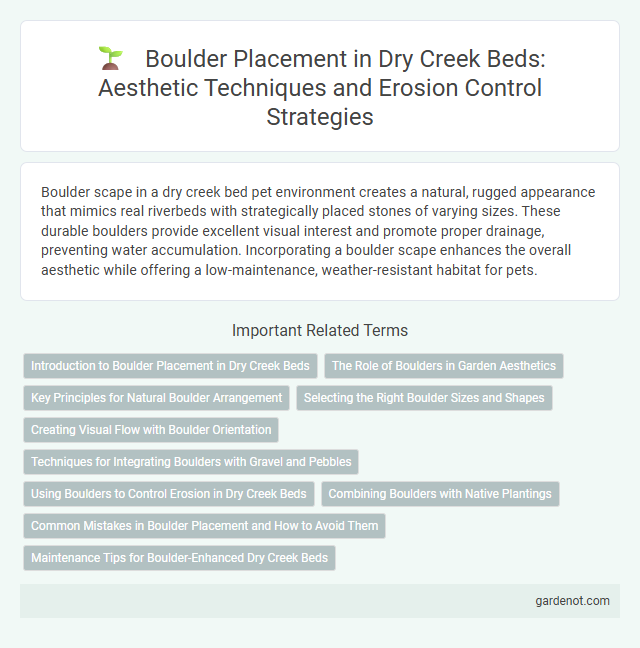Boulder scape in a dry creek bed pet environment creates a natural, rugged appearance that mimics real riverbeds with strategically placed stones of varying sizes. These durable boulders provide excellent visual interest and promote proper drainage, preventing water accumulation. Incorporating a boulder scape enhances the overall aesthetic while offering a low-maintenance, weather-resistant habitat for pets.
Introduction to Boulder Placement in Dry Creek Beds
Boulder placement in dry creek beds plays a crucial role in enhancing erosion control and stabilizing the landscape. Strategic positioning of variously sized boulders creates natural flow patterns, reducing water velocity during rain events and minimizing soil displacement. Properly integrated boulder scapes also contribute to aesthetic appeal, blending functionality with natural beauty in xeriscape and drought-tolerant designs.
The Role of Boulders in Garden Aesthetics
Boulders in garden aesthetics create natural focal points that enhance the visual texture and depth of a dry creek bed. Their irregular shapes and varied sizes contribute to a dynamic landscape design, promoting a sense of rugged elegance. Strategically placed boulders also support plant life by providing shade and moisture retention, enriching the garden's ecological balance.
Key Principles for Natural Boulder Arrangement
Natural boulder arrangement in dry creek beds emphasizes irregular shapes and varying sizes to mimic authentic geological patterns, enhancing visual interest and structural stability. Positioning boulders to follow the natural contours of the landscape supports water flow management and erosion control, reinforcing ecosystem resilience. Integrating native vegetation around boulders fosters habitat diversity and blends the structure seamlessly into the natural environment.
Selecting the Right Boulder Sizes and Shapes
Choosing the right boulder sizes and shapes is essential for creating a visually appealing and functional dry creek bed. Larger, flat boulders provide stability and anchor the design, while smaller rounded stones fill gaps and enhance natural flow. Selecting boulders with varied textures and colors adds dimension and mimics natural waterway patterns effectively.
Creating Visual Flow with Boulder Orientation
Strategically orienting boulders within a dry creek bed enhances visual flow by guiding the eye along natural pathways and mimicking water movement. Placing larger, elongated rocks parallel to the creek's contour emphasizes direction and continuity in the landscape design. Varied textures and sizes create depth while maintaining cohesion, making the boulder placement appear organic and intentional.
Techniques for Integrating Boulders with Gravel and Pebbles
Strategically placing boulders within a dry creek bed creates natural focal points that enhance visual depth and texture. Techniques such as partially embedding boulders in gravel and varying pebble sizes around their base replicate natural erosion patterns and improve stability. Careful layering of materials ensures proper drainage and prevents soil erosion, maintaining the creek bed's authentic rugged appearance.
Using Boulders to Control Erosion in Dry Creek Beds
Using boulders in dry creek beds effectively controls erosion by stabilizing soil and redirecting water flow, reducing sediment displacement during heavy rainfall. Strategic placement of large, angular boulders creates natural barriers that slow runoff velocity, preventing channel degradation and promoting sediment deposition. This method enhances creek bed resilience while maintaining the natural landscape aesthetics and supporting local vegetation growth.
Combining Boulders with Native Plantings
Integrating large boulders with native plantings in dry creek beds creates a naturalistic and sustainable landscape that enhances soil stability and water retention. Native plants such as blue fescue, sedum, and black-eyed Susan thrive around the textured surface of boulders, providing erosion control while supporting local biodiversity. This combination mimics natural waterways, reduces maintenance needs, and improves overall ecosystem health in arid environments.
Common Mistakes in Boulder Placement and How to Avoid Them
Incorrect boulder placement in dry creek beds often disrupts water flow, causing erosion or pooling that undermines the landscape's natural function. Avoid overloading small areas with large boulders, which can create instability and detract from the intended aesthetic balance of the space. Strategically spacing boulders based on their size and aligning them with the natural contours ensures effective water diversion and enhances visual harmony.
Maintenance Tips for Boulder-Enhanced Dry Creek Beds
Regular inspection of boulders in dry creek beds prevents erosion and maintains structural integrity by identifying displacement or cracks early. Removing debris such as leaves and sediment helps maintain proper water flow and prevents blockages around the boulders. Applying a sealant to the boulder surfaces can reduce weathering effects and prolong the lifespan of the dry creek bed installation.
Boulder scape Infographic

 gardenot.com
gardenot.com